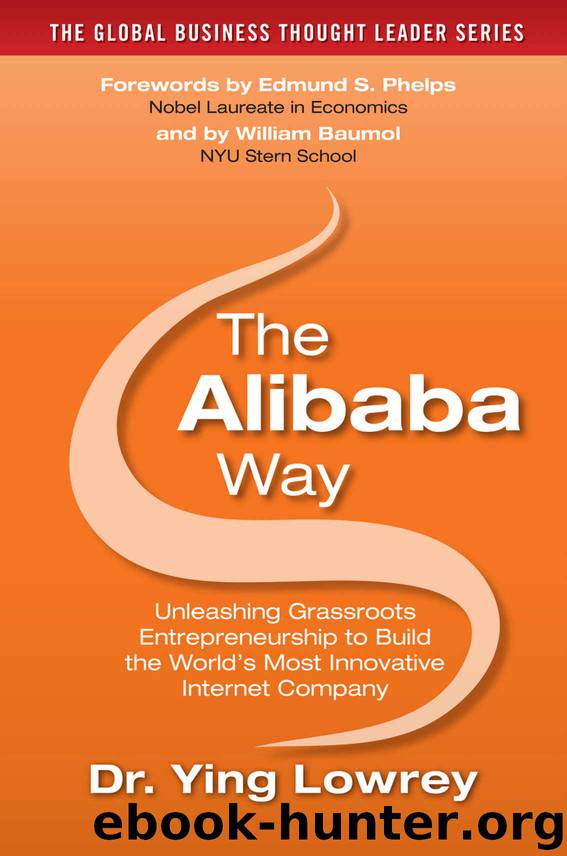The Alibaba Way: Unleashing Grass-Roots Entrepreneurship to Build the World's Most Innovative Internet Company (The Global Business Thought Leader Series) by Lowrey Ying & Lowrey Ying

Author:Lowrey, Ying & Lowrey, Ying [Lowrey, Ying]
Language: eng
Format: epub
Publisher: McGraw-Hill Education
Published: 2016-02-12T05:00:00+00:00
Consumer-to-Business Innovations
Consumer-to-business (C2B) is a business model in which consumers (individuals) also create value by working together with companies via the internet. This model allows consumers to share in the use of Big Data. Businesses profit from the willingness of consumers to name their own price, or contribute data, or provide links to their products, while consumers profit from reduced-price products, direct payment, flexibility, and so on.
In 2012 the C2B advance-sales model that Alibaba pioneered brought a ray of light to the problem of overstocked inventories in China. In invisible fashion this model began to ameliorate what had become a dire situation. The so-called C2B supply-chain model in fact takes consumer demand as its starting point. Its end point is satisfying that demand. As a concept it encompasses the convergence of consumer demand that is enabled by e-commerce platforms as well as the restructuring of corporate supply chains that is being done in order to provide convenient services to both sides. C2B also encompasses the various services provided by service providers, including logistics, information, finance, and so on, as well as the transaction services provided by intermediary organizations, including legal assistance, design, pricing, consulting, and trades. Information on demand is first generated by the consumer. Through e-commerce platforms it moves in a reverse direction as it is transmitted to retailers, agents, branded companies, suppliers, and intermediaries. In a short period of time this information can assemble quantities of consumer-demand information from individual consumers. This then can provide companies with concentrations of large volumes of orders. After receiving these orders, companies may optimize the results—select those that they choose to supply with product, depending on whether they want to start at the end, the middle, or even the beginning of the supply chain. They can define and lock in consumers more accurately, which allows them to prepare product in advance, to clear out inventories, to manage their upstream supply chains more efficiently, and to lower production costs, logistical costs, and inventory costs to a very great extent. The C2B supply-chain model can therefore satisfy the individual demands of consumers, but it can also lower inventories to the maximum extent possible for corporations. It can safeguard the seller’s profits while also realizing a win-win situation for all.
Many companies in China are facing a crisis in how they manage inventories, due to their extremely large amounts of overstocked product. The garment industry is one example. In the first three quarters of 2012, the total value of inventories held just by companies that have been listed on the market came to RMB 73.07 billion. One well-known brand even revealed that the value of its inventories has risen to the enormous figure of RMB 25 billion. Data from the National Bureau of Statistics show that in the first ten months of 2012, China’s garments and accessories industry had realized a mere RMB 70.81 billion in total profits. This seems to confirm the rueful comment made by factory managers of garment companies who say that they work hard all year, but the results of their efforts simply lie around in warehouses.
Download
This site does not store any files on its server. We only index and link to content provided by other sites. Please contact the content providers to delete copyright contents if any and email us, we'll remove relevant links or contents immediately.
Bad Blood by John Carreyrou(6581)
Rich Dad Poor Dad by Robert T. Kiyosaki(6513)
Principles: Life and Work by Ray Dalio(6296)
Playing to Win_ How Strategy Really Works by A.G. Lafley & Roger L. Martin(6082)
Management Strategies for the Cloud Revolution: How Cloud Computing Is Transforming Business and Why You Can't Afford to Be Left Behind by Charles Babcock(4546)
The Confidence Code by Katty Kay(4220)
Thinking in Bets by Annie Duke(4184)
American Kingpin by Nick Bilton(3817)
Delivering Happiness by Tony Hsieh(3394)
Project Animal Farm: An Accidental Journey into the Secret World of Farming and the Truth About Our Food by Sonia Faruqi(3189)
The Power of Habit by Charles Duhigg(3093)
The Tyranny of Metrics by Jerry Z. Muller(3028)
Brotopia by Emily Chang(3026)
Mastering Bitcoin: Programming the Open Blockchain by Andreas M. Antonopoulos(3010)
The Marketing Plan Handbook: Develop Big-Picture Marketing Plans for Pennies on the Dollar by Robert W. Bly(3005)
I Live in the Future & Here's How It Works by Nick Bilton(2959)
The Content Trap by Bharat Anand(2887)
Applied Empathy by Michael Ventura(2864)
Building a StoryBrand by Donald Miller(2862)
